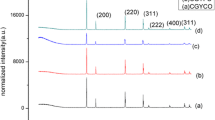Abstract
Acceptor doped-ceria is a possible electrolyte material for the IT-SOFC (intermediate temperature solid oxide fuel cell) due to its high oxygen-ion conductivity. However, its use has been limited by its mechanical weakness and the appearance of electronic conductivity in reducing condition. In this study, alumina was selected as an additive in the doped-ceria to see if it increases the oxygen-ion conductivity and mechanical strength. Effects of alumina addition in doped ceria were studied as a function of alumina content and acceptor (Gd) content.
The electrical conductivity of (Ce1−x Gd x O2−δ)1−y + (Al2O3) y (x = 0–0.35, y = 0–0.10) was measured by using impedance spectroscopy. The grain conductivity of Ce0.8Gd0.2O2-δ (GDC20) with 5 mol% alumina increased ∼3 times from that of GDC20 at 300∘C. The grain conductivity was even ∼2 times higher than that of Ce0.9Gd0.1O2−δ (GDC10) at 300∘C. The electrical conductivity of GDC20 without alumina addition, measured at 500∘C in air, rapidly decreased after exposure to reducing condition (Po2∼10−22 atm) at 800∘C. However, the decrease was much slower in GDC20 with alumina addition, indicating the improved mechanical strength.
Among the examined compositions, (Ce0.75Gd0.25 O2-δ)0.95 + (Al2O3)0.05 (GDC25A5) showed the highest conductivity at most temperatures.
Similar content being viewed by others
References
N.Q. Minh and T. Takahashi, Science and Technology of Ceramic Fuel Cells (Elsevier Science, Amsterdam, 1995) p. 1.
R.M. Dell and A. Hooper, Solid Electrolyte (Academic Press, 1978) p. 298.
T. Kudo and H. Obayashi, J. Electrochem. Soc., 123, 415 (1976).
T. Ishihara, H. Matsuda, and Y. Takita, Solid State Ionics, 147 (1995).
M. Breysse, M. Guenin, B. Claudel, H. Latreille, and J. Veron, J. Catalysis, 27, 275 (1972).
H. Inaba and H. Tagawa, Solid State Ionics, 83, 1 (1996).
H.L. Tuller and A.S. Nowick, J. Electrochem. Soc., 122, 255 (1975).
A. Atkinson, Solid State Ionics, 95, 249 (1997).
J.S. Lee, K.H. Choi, B.K. Ryu, B.C. Shin, and I.S. Kim, Ceramic International, 30, 807 (2004).
A. Atkinson and A. Selquk, Solid State Ionics, 134, 59 (2000).
B. Cales and J.F. Baumard, Rev. Int. Hautes Temper. Refract., 17, 137 (1980).
M. Mori. T. Itoh, O. Yamamoto, Y. Takeda, and T. Kawahara, Solid State Ionics, 74, 157 (1994).
T. Yamana and S. Nakamura, Solid State Ionics, 763, 53–56 (1992).
T. Zhang, Z. Zeng, H. Huang, P. Hing, and J. Kilner, Materials Letters, 57, 124 (2002).
A. Rizea, D. chirlesan, C. Petot, and G.P. Ervas, Solid State Ionics, 146, 341 (2002).
M. Miyayama, H. Yanagida, and A. Asada, Am. Ceram. Soc. Bull., 64, 660 (1985).
B. Kumar, C. Chen, C. Varanasi, and J.P. Fellner, Journal of Power Sources, 140, 12 (2005).
A.J. Feighery and J.T.S. Irvine, Solid State Ionics, 121, 209 (1999).
S. Lubke and H.D. Wiemhofer, Solid State Ionics, 117, 229 (1999).
S.R. Hui, J. Roller, X. Zhang, C.D. Petit, and Y. Xie, Solid Oxide Fuel Cells 4, edited by S.C. Singhal (The Electrochem. Soc. Inc., Pennington, 2005) p. 964.
T. Yoshimura and K. Ina, Solid State Ionics, 53, 763 (1992).
C.R.A. Catlow, Solid State Ionics, 12, 67 (1984).
D.J. Kim, J. Am. Ceram. Soc., 72, 1415 (1989).
M.M. Bucko, J. Euro. Cera. Soc., 24, 1305 (2004).
H. Yoshida, H. Deguchi, and T. Inagaki, Solid State Ionics, 140, 191 (2001).
T. Mori, J. Drennan, J.H. Lee, J.G. Li, and T. Ikegami, Solid State Ionics, 154, 461 (2002).
H. Yoshida, T. Inagaki, K. Miura, and Z. Ogumi, Solid State Ionics, 160, 109 (2003).
X.J. Chen, K.A. Khor, S.H. Chan, and L.G. Yu, Materials Sci. and Eng., A335, 246 (2002).
G.M. Christie and F.P.F. Berkel, Solid State Ionics, 83, 17 (1996).
C. Haavik, E.M. Ottesen, K. Nomura, J.A. Kilner, and T. Norby, Solid State Ionics, 174, 233 (2004).
Z. Shao, S. Haile, J. Ahn, P.D. Ronney, Z. Zhan, and S.A. Barnett, Nature, 435, 795 (2005).
B. Frankhanel, E. Muller, U. Mosler, and W. Siegel, J. European Cer. Soc., 21, 649 (2001).
Author information
Authors and Affiliations
Corresponding author
Rights and permissions
About this article
Cite this article
Kim, H.N., Park, H.J. & Choi, G.M. The effect of alumina addition on the electrical conductivity of Gd-doped ceria. J Electroceram 17, 793–798 (2006). https://doi.org/10.1007/s10832-006-7000-2
Received:
Revised:
Accepted:
Issue Date:
DOI: https://doi.org/10.1007/s10832-006-7000-2




